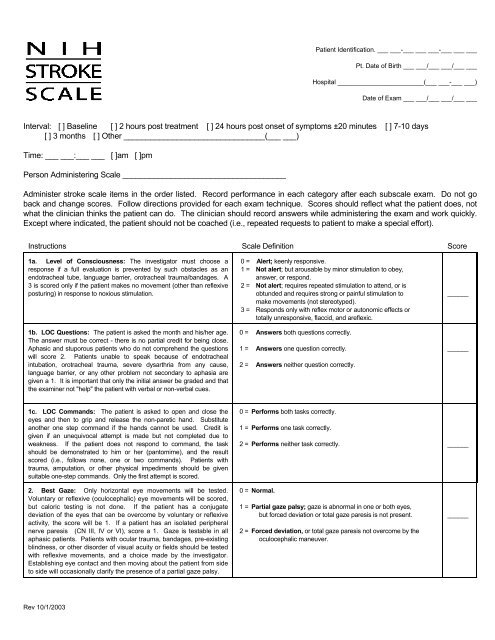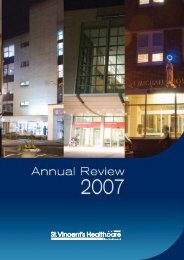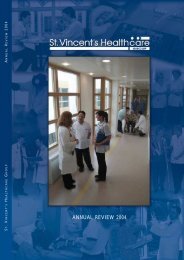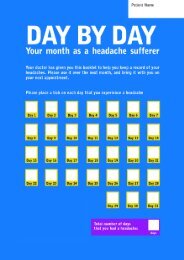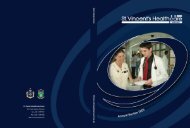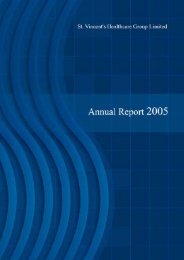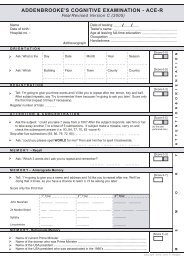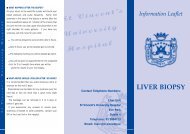NIH Stroke Scale - NINDS
NIH Stroke Scale - NINDS
NIH Stroke Scale - NINDS
You also want an ePaper? Increase the reach of your titles
YUMPU automatically turns print PDFs into web optimized ePapers that Google loves.
Patient Identification. ___ ___-___ ___ ___-___ ___ ___<br />
Pt. Date of Birth ___ ___/___ ___/___ ___<br />
Hospital ________________________(___ ___-___ ___)<br />
Date of Exam ___ ___/___ ___/___ ___<br />
Interval: [ ] Baseline [ ] 2 hours post treatment [ ] 24 hours post onset of symptoms ±20 minutes [ ] 7-10 days<br />
[ ] 3 months [ ] Other ________________________________(___ ___)<br />
Time: ___ ___:___ ___ [ ]am [ ]pm<br />
Person Administering <strong>Scale</strong> _____________________________________<br />
Administer stroke scale items in the order listed. Record performance in each category after each subscale exam. Do not go<br />
back and change scores. Follow directions provided for each exam technique. Scores should reflect what the patient does, not<br />
what the clinician thinks the patient can do. The clinician should record answers while administering the exam and work quickly.<br />
Except where indicated, the patient should not be coached (i.e., repeated requests to patient to make a special effort).<br />
Instructions <strong>Scale</strong> Definition Score<br />
1a. Level of Consciousness: The investigator must choose a<br />
response if a full evaluation is prevented by such obstacles as an<br />
endotracheal tube, language barrier, orotracheal trauma/bandages. A<br />
3 is scored only if the patient makes no movement (other than reflexive<br />
posturing) in response to noxious stimulation.<br />
1b. LOC Questions: The patient is asked the month and his/her age.<br />
The answer must be correct - there is no partial credit for being close.<br />
Aphasic and stuporous patients who do not comprehend the questions<br />
will score 2. Patients unable to speak because of endotracheal<br />
intubation, orotracheal trauma, severe dysarthria from any cause,<br />
language barrier, or any other problem not secondary to aphasia are<br />
given a 1. It is important that only the initial answer be graded and that<br />
the examiner not "help" the patient with verbal or non-verbal cues.<br />
0 = Alert; keenly responsive.<br />
1 = Not alert; but arousable by minor stimulation to obey,<br />
answer, or respond.<br />
2 = Not alert; requires repeated stimulation to attend, or is<br />
obtunded and requires strong or painful stimulation to<br />
make movements (not stereotyped).<br />
3 = Responds only with reflex motor or autonomic effects or<br />
totally unresponsive, flaccid, and areflexic.<br />
0 = Answers both questions correctly.<br />
1 = Answers one question correctly.<br />
2 = Answers neither question correctly.<br />
______<br />
______<br />
1c. LOC Commands: The patient is asked to open and close the<br />
eyes and then to grip and release the non-paretic hand. Substitute<br />
another one step command if the hands cannot be used. Credit is<br />
given if an unequivocal attempt is made but not completed due to<br />
weakness. If the patient does not respond to command, the task<br />
should be demonstrated to him or her (pantomime), and the result<br />
scored (i.e., follows none, one or two commands). Patients with<br />
trauma, amputation, or other physical impediments should be given<br />
suitable one-step commands. Only the first attempt is scored.<br />
0 = Performs both tasks correctly.<br />
1 = Performs one task correctly.<br />
2 = Performs neither task correctly. ______<br />
2. Best Gaze: Only horizontal eye movements will be tested.<br />
Voluntary or reflexive (oculocephalic) eye movements will be scored,<br />
but caloric testing is not done. If the patient has a conjugate<br />
deviation of the eyes that can be overcome by voluntary or reflexive<br />
activity, the score will be 1. If a patient has an isolated peripheral<br />
nerve paresis (CN III, IV or VI), score a 1. Gaze is testable in all<br />
aphasic patients. Patients with ocular trauma, bandages, pre-existing<br />
blindness, or other disorder of visual acuity or fields should be tested<br />
with reflexive movements, and a choice made by the investigator.<br />
Establishing eye contact and then moving about the patient from side<br />
to side will occasionally clarify the presence of a partial gaze palsy.<br />
0 = Normal.<br />
1 = Partial gaze palsy; gaze is abnormal in one or both eyes,<br />
but forced deviation or total gaze paresis is not present.<br />
2 = Forced deviation, or total gaze paresis not overcome by the<br />
oculocephalic maneuver.<br />
______<br />
Rev 10/1/2003
Patient Identification. ___ ___-___ ___ ___-___ ___ ___<br />
Pt. Date of Birth ___ ___/___ ___/___ ___<br />
Hospital ________________________(___ ___-___ ___)<br />
Date of Exam ___ ___/___ ___/___ ___<br />
Interval: [ ] Baseline [ ] 2 hours post treatment [ ] 24 hours post onset of symptoms ±20 minutes [ ] 7-10 days<br />
[ ] 3 months [ ] Other ________________________________(___ ___)<br />
3. Visual: Visual fields (upper and lower quadrants) are tested by<br />
confrontation, using finger counting or visual threat, as appropriate.<br />
Patients may be encouraged, but if they look at the side of the<br />
moving fingers appropriately, this can be scored as normal. If there is<br />
unilateral blindness or enucleation, visual fields in the remaining eye<br />
are scored. Score 1 only if a clear-cut asymmetry, including<br />
quadrantanopia, is found. If patient is blind from any cause, score 3.<br />
Double simultaneous stimulation is performed at this point. If there is<br />
extinction, patient receives a 1, and the results are used to respond to<br />
item 11.<br />
4. Facial Palsy: Ask – or use pantomime to encourage – the patient<br />
to show teeth or raise eyebrows and close eyes. Score symmetry of<br />
grimace in response to noxious stimuli in the poorly responsive or<br />
non-comprehending patient. If facial trauma/bandages, orotracheal<br />
tube, tape or other physical barriers obscure the face, these should<br />
be removed to the extent possible.<br />
5. Motor Arm: The limb is placed in the appropriate position: extend<br />
the arms (palms down) 90 degrees (if sitting) or 45 degrees (if<br />
supine). Drift is scored if the arm falls before 10 seconds. The<br />
aphasic patient is encouraged using urgency in the voice and<br />
pantomime, but not noxious stimulation. Each limb is tested in turn,<br />
beginning with the non-paretic arm. Only in the case of amputation or<br />
joint fusion at the shoulder, the examiner should record the score as<br />
untestable (UN), and clearly write the explanation for this choice.<br />
0 = No visual loss.<br />
1 = Partial hemianopia.<br />
2 = Complete hemianopia.<br />
3 = Bilateral hemianopia (blind including cortical blindness).<br />
0 = Normal symmetrical movements.<br />
1 = Minor paralysis (flattened nasolabial fold, asymmetry on<br />
smiling).<br />
2 = Partial paralysis (total or near-total paralysis of lower<br />
face).<br />
3 = Complete paralysis of one or both sides (absence of<br />
facial movement in the upper and lower face).<br />
0 = No drift; limb holds 90 (or 45) degrees for full 10 seconds.<br />
1 = Drift; limb holds 90 (or 45) degrees, but drifts down before<br />
full 10 seconds; does not hit bed or other support.<br />
2 = Some effort against gravity; limb cannot get to or<br />
maintain (if cued) 90 (or 45) degrees, drifts down to bed,<br />
but has some effort against gravity.<br />
3 = No effort against gravity; limb falls.<br />
4 = No movement.<br />
UN = Amputation or joint fusion, explain: _____________________<br />
5a. Left Arm<br />
5b. Right Arm<br />
______<br />
______<br />
______<br />
______<br />
6. Motor Leg: The limb is placed in the appropriate position: hold<br />
the leg at 30 degrees (always tested supine). Drift is scored if the leg<br />
falls before 5 seconds. The aphasic patient is encouraged using<br />
urgency in the voice and pantomime, but not noxious stimulation.<br />
Each limb is tested in turn, beginning with the non-paretic leg. Only<br />
in the case of amputation or joint fusion at the hip, the examiner<br />
should record the score as untestable (UN), and clearly write the<br />
explanation for this choice.<br />
0 = No drift; leg holds 30-degree position for full 5 seconds.<br />
1 = Drift; leg falls by the end of the 5-second period but does<br />
not hit bed.<br />
2 = Some effort against gravity; leg falls to bed by 5<br />
seconds, but has some effort against gravity.<br />
3 = No effort against gravity; leg falls to bed immediately.<br />
4 = No movement.<br />
UN = Amputation or joint fusion, explain: ________________<br />
6a. Left Leg<br />
______<br />
6b. Right Leg<br />
Rev 10/1/2003
Patient Identification. ___ ___-___ ___ ___-___ ___ ___<br />
Pt. Date of Birth ___ ___/___ ___/___ ___<br />
Hospital ________________________(___ ___-___ ___)<br />
Date of Exam ___ ___/___ ___/___ ___<br />
Interval: [ ] Baseline [ ] 2 hours post treatment [ ] 24 hours post onset of symptoms ±20 minutes [ ] 7-10 days<br />
[ ] 3 months [ ] Other ________________________________(___ ___)<br />
______<br />
7. Limb Ataxia: This item is aimed at finding evidence of a unilateral<br />
cerebellar lesion. Test with eyes open. In case of visual defect,<br />
ensure testing is done in intact visual field. The finger-nose-finger<br />
and heel-shin tests are performed on both sides, and ataxia is scored<br />
only if present out of proportion to weakness. Ataxia is absent in the<br />
patient who cannot understand or is paralyzed. Only in the case of<br />
amputation or joint fusion, the examiner should record the score as<br />
untestable (UN), and clearly write the explanation for this choice. In<br />
case of blindness, test by having the patient touch nose from<br />
extended arm position.<br />
8. Sensory: Sensation or grimace to pinprick when tested, or<br />
withdrawal from noxious stimulus in the obtunded or aphasic patient.<br />
Only sensory loss attributed to stroke is scored as abnormal and the<br />
examiner should test as many body areas (arms [not hands], legs,<br />
trunk, face) as needed to accurately check for hemisensory loss. A<br />
score of 2, “severe or total sensory loss,” should only be given when<br />
a severe or total loss of sensation can be clearly demonstrated.<br />
Stuporous and aphasic patients will, therefore, probably score 1 or 0.<br />
The patient with brainstem stroke who has bilateral loss of sensation<br />
is scored 2. If the patient does not respond and is quadriplegic, score<br />
2. Patients in a coma (item 1a=3) are automatically given a 2 on this<br />
item.<br />
9. Best Language: A great deal of information about comprehension<br />
will be obtained during the preceding sections of the examination.<br />
For this scale item, the patient is asked to describe what is happening<br />
in the attached picture, to name the items on the attached naming<br />
sheet and to read from the attached list of sentences.<br />
Comprehension is judged from responses here, as well as to all of<br />
the commands in the preceding general neurological exam. If visual<br />
loss interferes with the tests, ask the patient to identify objects placed<br />
in the hand, repeat, and produce speech. The intubated patient<br />
should be asked to write. The patient in a coma (item 1a=3) will<br />
automatically score 3 on this item. The examiner must choose a<br />
score for the patient with stupor or limited cooperation, but a score of<br />
3 should be used only if the patient is mute and follows no one-step<br />
commands.<br />
10. Dysarthria: If patient is thought to be normal, an adequate<br />
sample of speech must be obtained by asking patient to read or<br />
repeat words from the attached list. If the patient has severe<br />
aphasia, the clarity of articulation of spontaneous speech can be<br />
rated. Only if the patient is intubated or has other physical barriers to<br />
producing speech, the examiner should record the score as<br />
untestable (UN), and clearly write an explanation for this choice. Do<br />
not tell the patient why he or she is being tested.<br />
0 = Absent.<br />
1 = Present in one limb.<br />
2 = Present in two limbs.<br />
UN = Amputation or joint fusion, explain: ________________<br />
0 = Normal; no sensory loss.<br />
1 = Mild-to-moderate sensory loss; patient feels pinprick is<br />
less sharp or is dull on the affected side; or there is a<br />
loss of superficial pain with pinprick, but patient is aware<br />
of being touched.<br />
2 = Severe to total sensory loss; patient is not aware of<br />
being touched in the face, arm, and leg.<br />
0 = No aphasia; normal.<br />
1 = Mild-to-moderate aphasia; some obvious loss of fluency<br />
or facility of comprehension, without significant<br />
limitation on ideas expressed or form of expression.<br />
Reduction of speech and/or comprehension, however,<br />
makes conversation about provided materials difficult<br />
or impossible. For example, in conversation about<br />
provided materials, examiner can identify picture or<br />
naming card content from patient’s response.<br />
2 = Severe aphasia; all communication is through fragmentary<br />
expression; great need for inference, questioning, and guessing<br />
by the listener. Range of information that can be exchanged is<br />
limited; listener carries burden of communication. Examiner<br />
cannot identify materials provided from patient response.<br />
3 = Mute, global aphasia; no usable speech or auditory<br />
comprehension.<br />
0 = Normal.<br />
1 = Mild-to-moderate dysarthria; patient slurs at least some<br />
words and, at worst, can be understood with some<br />
difficulty.<br />
2 = Severe dysarthria; patient's speech is so slurred as to be<br />
unintelligible in the absence of or out of proportion to<br />
any dysphasia, or is mute/anarthric.<br />
UN = Intubated or other physical barrier,<br />
explain:_____________________________<br />
______<br />
______<br />
______<br />
______<br />
Rev 10/1/2003
Patient Identification. ___ ___-___ ___ ___-___ ___ ___<br />
Pt. Date of Birth ___ ___/___ ___/___ ___<br />
Hospital ________________________(___ ___-___ ___)<br />
Date of Exam ___ ___/___ ___/___ ___<br />
Interval: [ ] Baseline [ ] 2 hours post treatment [ ] 24 hours post onset of symptoms ±20 minutes [ ] 7-10 days<br />
[ ] 3 months [ ] Other ________________________________(___ ___)<br />
11. Extinction and Inattention (formerly Neglect): Sufficient<br />
information to identify neglect may be obtained during the prior<br />
testing. If the patient has a severe visual loss preventing visual<br />
double simultaneous stimulation, and the cutaneous stimuli are<br />
normal, the score is normal. If the patient has aphasia but does<br />
appear to attend to both sides, the score is normal. The presence of<br />
visual spatial neglect or anosagnosia may also be taken as evidence<br />
of abnormality. Since the abnormality is scored only if present, the<br />
item is never untestable.<br />
0 = No abnormality.<br />
1 = Visual, tactile, auditory, spatial, or personal inattention<br />
or extinction to bilateral simultaneous stimulation in one<br />
of the sensory modalities.<br />
2 = Profound hemi-inattention or extinction to more than<br />
one modality; does not recognize own hand or orients<br />
to only one side of space.<br />
______<br />
______<br />
______<br />
Rev 10/1/2003
You know how.<br />
Down to earth.<br />
I got home from work.<br />
Near the table in the dining<br />
room.<br />
They heard him speak on the<br />
radio last night.
MAMA<br />
TIP – TOP<br />
FIFTY – FIFTY<br />
THANKS<br />
HUCKLEBERRY<br />
BASEBALL PLAYER


